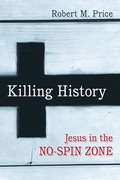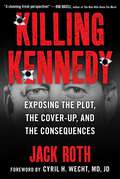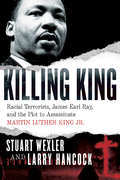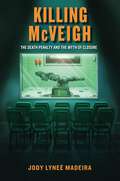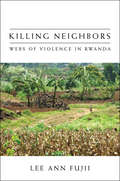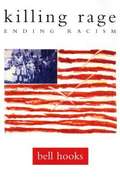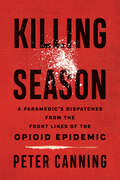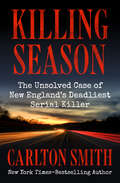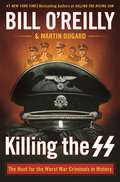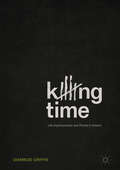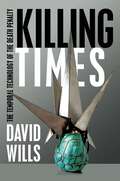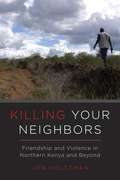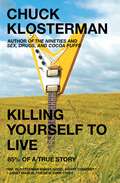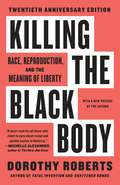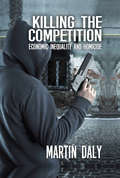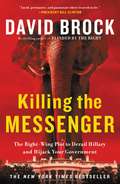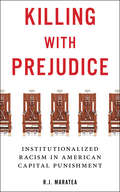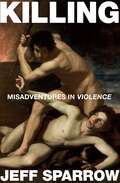- Table View
- List View
Killing History
by Robert M. PriceKilling Jesus, the bestselling blockbuster by Bill O'Reilly, claims to be a purely historical account of the events in the life of Jesus leading up to his crucifixion. New Testament scholar Robert M. Price (a member of the Jesus Seminar) shows how unfounded this claim is in this critical review of O'Reilly's work. In fact, he judges the book to be the number one source of misinformation on Jesus today. Ignoring over one hundred years of New Testament scholarship, O'Reilly and his coauthor, Martin Dugard, have produced what Price describes as a Christian historical thriller that plays fast and loose with the facts. Price goes through the key events of Jesus' later life as described in the gospels and retold in Killing Jesus, painstakingly showing in each case what scholars know and don't know. Using humor, down-to-earth analogies, and witty sarcasm--not unlike O'Reilly's own interview style--Price makes it clear that O'Reilly's book is more historical novel than a work of serious history. By cobbling together the four gospel stories, ignoring the contradictions, and adding plenty of quasi-historical background embellishments, O'Reilly and Dugard have created a good narrative that resonates with a lot of Christians. Entertaining reading this may be, but history it is not.Killing History provides lay readers with an accessible introduction to New Testament scholarship while showing the many problems in O'Reilly's book.
Killing Kennedy: Exposing the Plot, the Cover-Up, and the Consequences
by Jack RothStartling new insights into the JFK assassination In Killing Kennedy: Exposing the Plot, the Cover-Up, and the Consequences, author Jack Roth interviews researchers, scholars, eyewitnesses, and family members of those who were part of the tangled web of US intelligence operations associated with the Cold War and the circumstances surrounding the assassination of John F. Kennedy. The author asks important questions, including why the assassination still matters today and what the lasting ripple effects have been since that fateful day. The Kennedy assassination represents one of the most impactful events in not only American but also world history, and this book represents an important addendum to understanding its enduring significance. On November 22, 1963, the duly elected president of the United States was murdered in cold blood, forever destroying &“Camelot&” and national optimism for world peace. Gleaning a &“people&’s history&” of the assassination through dozens of insightful and heartfelt interviews, Roth presents a riveting narrative by creating a respectful, well-crafted, and emotionally charged book from which both older and younger generations will gain a greater understanding of our nation&’s history and current status in the modern world.
Killing King: Racial Terrorists, James Earl Ray, and the Plot to Assassinate Martin Luther King Jr.
by Larry Hancock Stuart WexlerPublished in time for the 50th anniversary of Dr. Martin Luther King Jr.’s assassination, Killing King uncovers previously unknown FBI files and sources, as well as new forensics to convincingly make the case that King was assassinated by a long–simmering conspiracy orchestrated by the racial terrorists who were responsible for the Mississippi Burning murders. This explosive book details the long–simmering effort by a group of the nation’s most violent racial terrorists to kill Dr. Martin Luther King Jr. Killing King convincingly makes the case that while James Earl Ray was part of the assassination plot to kill King, the preponderance of evidence also demonstrates a clear and well–orchestrated conspiracy. Thoroughly researched and impeccably documented, the book reveals a network of racist militants led by Sam Bowers, head of the White Knights of the Ku Klux Klan of Mississippi, who were dedicated to the cause of killing King. The White Knights were formed in the cauldron of anti–integrationist resistance that was Mississippi in the early 1960s and were responsible for more than three hundred separate acts of violence, including the infamous Mississippi Burning murders. The authors have located previously unknown FBI files and sources that detail a White Knight bounty offer, information from an individual who carried money for the assassination, and forensics information regarding unmatched fingerprints and an audio recording of an admission that a key suspect obtained a weapon to be used in killing King. For years, Americans have debated issues with this crime. With Killing King, we are ever closer to an accurate understanding of how and why Dr. King was killed.
Killing McVeigh: The Death Penalty and the Myth of Closure
by Jody Lyneé MadeiraOn April 19, 1995, Timothy McVeigh detonated a two-ton truck bomb that felled the Alfred P. Murrah Federal Building in Oklahoma City, killing 168 people. On June 11, 2001, an unprecedented 242 witnesses watched him die by lethal injection.In the aftermath of the bombings, American public commentary almost immediately turned to “closure” rhetoric. Reporters and audiences alike speculated about whether victim’s family members and survivors could get closure from memorial services, funerals, legislation, monuments, trials, and executions. But what does “closure” really mean for those who survive—or lose loved ones in—traumatic acts? In the wake of such terrifying events, is closure a realistic or appropriate expectation?In Killing McVeigh, Jody Lyneé Madeira uses the Oklahoma City bombing as a case study to explore how family members and other survivors come to terms with mass murder. The book demonstrates the importance of understanding what closure really is before naively asserting it can or has been reached.
Killing Neighbors: Webs of Violence in Rwanda
by Lee Ann FujiiIn the horrific events of the mid-1990s in Rwanda, tens of thousands of Hutu killed their Tutsi friends, neighbors, even family members. That ghastly violence has overshadowed a fact almost as noteworthy: that hundreds of thousands of Hutu killed no one. In a transformative revisiting of the motives behind and specific contexts surrounding the Rwandan genocide, Lee Ann Fujii focuses on individual actions rather than sweeping categories. Fujii argues that ethnic hatred and fear do not satisfactorily explain the mobilization of Rwandans one against another. Extensive interviews in Rwandan prisons and two rural communities from the basics for her claim that mass participation in the genocide was not the result of ethnic antagonisms. Rather, the social context of action was critical. Book jacket.
Killing Others: A Natural History of Ethnic Violence
by Matthew LangeIn Killing Others, Matthew Lange explores why humans ruthlessly attack and kill people from other ethnic communities. Drawing on an array of cases from around the world and insight from a variety of disciplines, Lange provides a simple yet powerful explanation that pinpoints the influential role of modernity in the growing global prevalence of ethnic violence over the past two hundred years. He offers evidence that a modern ethnic mind-set is the ultimate and most influential cause of ethnic violence. Throughout most of human history, people perceived and valued small sets of known acquaintances and did not identify with ethnicities. Through education, state policy, and other means, modernity ultimately created broad ethnic consciousnesses that led to emotional prejudice, whereby people focus negative emotions on entire ethnic categories, and ethnic obligation, which pushes people to attack Others for the sake of their ethnicity. Modern social transformations also provided a variety of organizational resources that put these motives into action, thereby allowing ethnic violence to emerge as a modern menace. Yet modernity takes many forms and is not constant, and past trends in ethnic violence are presently transforming. Over the past seventy years, the earliest modernizers have transformed from champions of ethnic violence into leaders of intercommunal peace, and Killing Others offers evidence that the emergence of robust rights-based democracy—in combination with effective states and economic development—weakened the motives and resources that commonly promote ethnic violence.
Killing Rage
by Eamon Collins Mick McgovernSince the 1970s, people have been murdering their neighbors in Northern Ireland. This book is the true account of the small-town violence and terror which lies behind the headlines.
Killing Rage: Ending Racism
by Bell HooksOne of our country's premier cultural and social critics, Bell Hooks has always maintained that eradicating racism and eradicating sexism must go hand in hand. These twenty-three essays are written from a black and feminist perspective, and they tackle the bitter difficulties of racism by envisioning a world without it. They address a spectrum of topics having to do with race and racism in the United States: psychological trauma among African Americans; friendship between black women and white women; anti-Semitism and racism; and internalized racism in movies and the media. And in the title essay, Hooks writes about the "Killing Rage" -- the fierce anger of black people stung by repeated instances of everyday racism -- finding in that rage a healing source of love and strength and a catalyst for positive change.
Killing Season: A Paramedic's Dispatches from the Front Lines of the Opioid Epidemic
by Peter CanningA devastating, empathetic look at the opioid epidemic in the United States, through the eyes of a paramedic on the front lines.[I] set my cardiac monitor down by the young man's head. He is lifeless, his face white with a blue tinge. I apply the defibrillator pads to his hairless chest... A week from today, after the young man's brain shows no signs of electrical activity, the medical staff will take the breathing tube out, and with his family gathered by his side, he will pass away at the age of twenty-three. When Peter Canning started work as a paramedic on the streets of Hartford, Connecticut, twenty-five years ago, he believed drug users were victims only of their own character flaws. Although he took care of them, he did not care for them. But as the overdoses escalated, Canning began asking his patients how they had gotten started on their perilous journeys. And while no two tales were the same, their heartrending similarities changed Canning's view and moved him to educate himself about the science of addiction. Armed with that understanding, he began his fight against the stigmatization of users.In Killing Season, we ride along with Canning through the streets of Hartford as he tells stories of opioid overdose from a street-level vantage point. A first responder to hundreds of overdoses throughout the rise of America's epidemic, Canning has seen the impact of prescription painkillers, heroin, and the deadly synthetic opioid fentanyl firsthand. Bringing us into the room (or the car, or the portable toilet) with the victims of this epidemic, Canning explains how he came to favor harm reduction, which advocates for needle exchange, community naloxone, and safe-injection sites.Through the rapid-fire nature of one paramedic's view of addiction and overdose, readers will come to understand more than just the science and misguided policies behind the opioid epidemic. They'll also share in Canning's developing empathy. Stripping away the stigma of addiction through stories that are hard-hitting, poignant, sad, confessional, funny, and overall, human, Killing Season will change minds about the epidemic, help obliterate stigma, and save lives.
Killing Season: The Unsolved Case of New England's Deadliest Serial Killer
by Carlton SmithA New York Times–bestselling journalist traces a string of unsolved murders—and the botched investigation that let the New Bedford Highway Killer walk away. Over the course of seven months in 1988, eleven women disappeared off the streets of New Bedford, Massachusetts, a gloomy, drug-addled coastal town that was once the whaling capital of the world. Nine turned up dead. Two were never found. And the perpetrator remains unknown to this day. How could such a thing happen? How, in what was once one of America’s richest cities, could the authorities let their most vulnerable citizens down this badly? As Carlton Smith, a Pulitzer Prize finalist for his coverage of the Green River Killer case, demonstrates in this riveting account, it was the inability of police officers and politicians alike to set aside their personal agendas that let a psychopath off the hook. In Killing Season, Smith takes readers into a close-knit community of working-class men and women, an underworld of prostitution and drug abuse, and the halls of New England law enforcement to tell the story of an epic failure of justice.
Killing The American Dream: How Anti-immigration Extremists Are Destroying The Nation
by Pilar MarreroAs the US deports record numbers of illegal immigrants and local and state governments scramble to pass laws resembling dystopian police states where anyone can be questioned and neighbors are encouraged to report on one another, violent anti-immigration rhetoric is growing across the nation. Against this tide of hysteria, Pilar Marrero reveals how damaging this rise in malice toward immigrants is not only to the individuals, but to our country as a whole. Marrero explores the rise in hate groups and violence targeting the foreign-born from the 1986 Immigration Act to the increasing legislative madness of laws like Arizona's SB1070 which allows law officers to demand documentation from any individual with "reasonable suspicion" of citizenship, essentially encouraging states and municipalities to form their own self-contained nation-states devoid of immigrants. Assessing the current status quo of immigration, Marrero reveals the economic drain these ardent anti-immigration policies have as they deplete the nation of an educated work force, undermine efforts to stabilize tax bases and social security, and turn the American Dream from a time honored hallmark of the nation into an unattainable fantasy for all immigrants of the present and future.
Killing The SS: The Hunt for the Worst War Criminals in History (Bill O'Reilly's Killing Ser.)
by Bill O'Reilly Martin DugardConfronting Nazi evil is the subject of the latest installment in the mega-bestselling Killing series <P><P>As the true horrors of the Third Reich began to be exposed immediately after World War II, the Nazi war criminals who committed genocide went on the run. A few were swiftly caught, including the notorious SS leader, Heinrich Himmler. Others, however, evaded capture through a sophisticated Nazi organization designed to hide them. Among those war criminals were Josef Mengele, the “Angel of Death” who performed hideous medical experiments at Auschwitz; Martin Bormann, Hitler’s brutal personal secretary; Klaus Barbie, the cruel "Butcher of Lyon"; and perhaps the most awful Nazi of all: Adolf Eichmann. <P><P>Killing the SS is the epic saga of the espionage and daring waged by self-styled "Nazi hunters." This determined and disparate group included a French husband and wife team, an American lawyer who served in the army on D-Day, a German prosecutor who had signed an oath to the Nazi Party, Israeli Mossad agents, and a death camp survivor. Over decades, these men and women scoured the world, tracking down the SS fugitives and bringing them to justice, which often meant death. <P><P>Written in the fast-paced style of the Killing series, Killing the SS will educate and stun the reader. <P><P>The final chapter is truly shocking.
Killing Time: Archaeology and the First World War
by Nicholas J SaundersThe passage of time has all but extinguished any living memory of the Great War of 1914-1918 but the experiences of those who fought in the trenches of the Somme and Flanders have since become epic history and the stuff of legend. Today, hardly a month passes without some dramatic and sometimes tragic discovery being made along the old killing fields of the Western Front. Graves of British soldiers buried during battle - still lying in rows seemingly arm in arm or found crouching at the entrance to a dugout; whole 'underground cities' of trenches, dugouts and shelters have been preserved in the mud; field hospitals carved out of the chalk country of the Somme marked with graffiti; unexploded bombs and gas canisters - all of tehse are the poignant and sometimes deadly legacies fo a war we can never forget. Killing Time digs beneath the surface of war to uncover the living reality left behind. Archaeologist and anthropologist Nicholas J Saunders brings together a wealth of discoveries in family photographs, diaries, souvenirs and in the trenches to offer fresh insights into the human dimension of warfare in the contemporary past.
Killing Time: Life Imprisonment And Parole In Ireland
by Diarmuid GriffinLittle is known about life imprisonment and the process of releasing offenders back into the community in Ireland. Addressing this scarcity of information, Griffin’s empirical study examines the legal and policy framework surrounding life imprisonment and parole. Through an analysis of the rationales expressed by parole decision-makers in the exercise of their discretionary power of release, it is revealed that decision-makers view public protection as central to the process. However, the risk of reoffending features amidst an array of other factors that also influence parole outcomes including personal interpretations of the purposes of punishment, public opinion and the political landscape within which parole operates. The findings of this study are employed to provide a rationale for the upward trend in time served by life sentence prisoners prior to release in recent times. With reform of parole now on the political agenda, will a more formal process of release operate to constrain the increase in time served witnessed over the last number of decades or will the upward trajectory continue unabated?
Killing Times: The Temporal Technology of the Death Penalty
by David WillsKilling Times begins with the deceptively simple observation—made by Jacques Derrida in his seminars on the topic—that the death penalty mechanically interrupts mortal time by preempting the typical mortal experience of not knowing at what precise moment we will die. Through a broader examination of what constitutes mortal temporality, David Wills proposes that the so-called machinery of death summoned by the death penalty works by exploiting, or perverting, the machinery of time that is already attached to human existence. Time, Wills argues, functions for us in general as a prosthetic technology, but the application of the death penalty represents a new level of prosthetic intervention into what constitutes the human.Killing Times traces the logic of the death penalty across a range of sites. Starting with the legal cases whereby American courts have struggled to articulate what methods of execution constitute “cruel and unusual punishment,” Wills goes on to show the ways that technologies of death have themselves evolved in conjunction with ideas of cruelty and instantaneity, from the development of the guillotine and the trap door for hanging, through the firing squad and the electric chair, through today’s controversies surrounding lethal injection. Responding to the legal system’s repeated recourse to storytelling—prosecutors’ and politicians’ endless recounting of the horrors of crimes—Wills gives a careful eye to the narrative, even fictive spaces that surround crime and punishment.Many of the controversies surrounding capital punishment, Wills argues, revolve around the complex temporality of the death penalty: how its instant works in conjunction with forms of suspension, or extension of time; how its seeming correlation between egregious crime and painless execution is complicated by a number of different discourses. By pinpointing the temporal technology that marks the death penalty, Wills is able to show capital punishment’s expansive reach, tracing the ways it has come to govern not only executions within the judicial system, but also the opposed but linked categories of the suicide bombing and drone warfare. In discussing the temporal technology of death, Wills elaborates the workings both of the terrorist who produces a simultaneity of crime and “punishment” that bypasses judicial process, and of the security state, in whose remote-control killings the time-space coordinates of “justice” are compressed and at the same time disappear into the black hole of secrecy.Grounded in a deep ethical and political commitment to death penalty abolition, Wills’s engaging and powerfully argued book pushes the question of capital punishment beyond the confines of legal argument to show how the technology of capital punishment defines and appropriates the instant of death and reconfigures the whole of human mortality.
Killing Your Neighbors: Friendship and Violence in Northern Kenya and Beyond
by Jon HoltzmanNeighboring communities who once lived together in peace have committed some of the most disturbing genocidal violence in recent decades: ethnic cleansing in the former Yugoslavia; the slaughter of Tutsis in Rwanda; or Sunni-versus-Shia violence in today's Iraq. As these instances illustrate, lethal violence does not always come at the hands of outsiders or foreigners--it can come just as easily from someone who was once considered a friend. Employing a multisited, multivocal approach to ethnography, Killing Your Neighbors examines how peaceful neighbors become involved in lethal violence. It engages with a set of interlocking case studies in northern Kenya, focusing on sometimes-peaceful, sometimes violent interactions between Samburu herders and neighboring groups, interweaving Samburu narratives of key violent events with the narratives of neighboring groups on the other side of the same encounters. The book is, on one hand, an ethnography of particular people in a particular place, vividly portraying the complex and confusing dynamics of interethnic violence through the lives, words and intimate experiences of individuals variously involved in and affected by these conflicts. At the same time, the book aims to use this particular case study to illustrate how the dynamics in northern Kenya provides comparative insights to well-known, compelling contexts of violence around the globe.
Killing Yourself to Live: 85% of a True Story
by Chuck KlostermanBuilding on the national bestselling success of Sex, Drugs, and Cocoa Puffs, preeminent pop culture writer Chuck Klosterman unleashes his best book yet--the story of his cross-country tour of sites where rock stars have died and his search for love, excitement, and the meaning of death.For 6,557 miles, Chuck Klosterman thought about dying. He drove a rental car from New York to Rhode Island to Georgia to Mississippi to Iowa to Minneapolis to Fargo to Seattle, and he chased death and rock 'n' roll all the way. Within the span of twenty-one days, Chuck had three relationships end--one by choice, one by chance, and one by exhaustion. He snorted cocaine in a graveyard. He walked a half-mile through a bean field. A man in Dickinson, North Dakota, explained to him why we have fewer windmills than we used to. He listened to the KISS solo albums and the Rod Stewart box set. At one point, poisonous snakes became involved. The road is hard. From the Chelsea Hotel to the swampland where Lynyrd Skynyrd's plane went down to the site where Kurt Cobain blew his head off, Chuck explored every brand of rock star demise. He wanted to know why the greatest career move any musician can make is to stop breathing...and what this means for the rest of us.
Killing the Black Body
by Dorothy RobertsThis is a no-holds-barred response to the liberal and conservative retreat from an assertive, activist, and socially transformative civil rights agenda of recent years--using a black feminist lens and the issue of the impact of recent legislation, social policy, and welfare "reform" on black women's--especially poor black women's--control over their bodies' autonomy and their freedom to bear and raise children with respect and dignity in a society whose white mainstream is determined to demonize, even criminalize their lives. It gives its readers a cogent legal and historical argument for a radically new , and socially transformative, definition of "liberty" and "equality" for the American polity from a black feminist perspective.
Killing the Black Body: Race, Reproduction and the Meaning of Liberty
by Dorothy RobertsThis is a no-holds-barred response to the liberal and conservative retreat from an assertive, activist, and socially transformative civil rights agenda of recent years--using a black feminist lens and the issue of the impact of recent legislation, social policy, and welfare "reform" on black women's--especially poor black women's--control over their bodies' autonomy and their freedom to bear and raise children with respect and dignity in a society whose white mainstream is determined to demonize, even criminalize their lives. It gives its readers a cogent legal and historical argument for a radically new, and socially transformative, definition of "liberty" and "equality" for the American polity from a black feminist perspective.
Killing the Black Body: Race, Reproduction, and the Meaning of Liberty
by Dorothy RobertsThe image of the “Welfare Queen” still dominates white America’s perceptions of Black women. It is an image that also continues to shape our government’s policies concerning Black women’s reproductive decisions. Proposed legislation to alleviate poverty focuses on plans to deny benefits to children born to welfare mothers and to require insertion of birth control implants as a condition of receiving aid. Meanwhile a booming fertility industry serves primarily infertile white couples. In Killing the Black Body, Northwestern University professor Dorothy Roberts exposes America’s systemic abuse of Black women’s bodies, from slave masters’ economic stake in bonded women’s fertility to government programs that coerced thousands of poor Black women into being sterilized as late as the 1970s. These abuses, Roberts argues, point not only to the degradation of Black motherhood but to the exclusion of Black women’s reproductive needs from the feminist agenda. Groundbreaking, authoritative, and timely, Killing the Black Body is both a powerful legal argument and a valuable aid for teachers, activists, and policy makers in creating a vision of reproductive freedom that respects each and every American.
Killing the Black Body: Race, Reproduction, and the Meaning of Liberty
by Dorothy RobertsThe image of the “Welfare Queen” still dominates white America’s perceptions of Black women. It is an image that also continues to shape our government’s policies concerning Black women’s reproductive decisions. Proposed legislation to alleviate poverty focuses on plans to deny benefits to children born to welfare mothers and to require insertion of birth control implants as a condition of receiving aid. Meanwhile a booming fertility industry serves primarily infertile white couples. In Killing the Black Body, Northwestern University professor Dorothy Roberts exposes America’s systemic abuse of Black women’s bodies, from slave masters’ economic stake in bonded women’s fertility to government programs that coerced thousands of poor Black women into being sterilized as late as the 1970s. These abuses, Roberts argues, point not only to the degradation of Black motherhood but to the exclusion of Black women’s reproductive needs from the feminist agenda. Groundbreaking, authoritative, and timely, Killing the Black Body is both a powerful legal argument and a valuable aid for teachers, activists, and policy makers in creating a vision of reproductive freedom that respects each and every American.
Killing the Competition: Economic Inequality and Homicide
by Martin DalyCriminologists have known for decades that income inequality is the best predictor of the local homicide rate, but why this is so has eluded them. There is a simple, compelling answer: most homicides are the denouements of competitive interactions between men. Relatively speaking, where desired goods are distributed inequitably and competition for those goods is severe, dangerous tactics of competition are appealing and a high homicide rate is just one of many unfortunate consequences. Killing the Competition is about this relationship between economic inequality and lethal interpersonal violence.Suggesting that economic inequality is a cause of social problems and violence elicits fierce opposition from inequality's beneficiaries. Three main arguments have been presented by those who would acquit inequality of the charges against it: that "absolute" poverty is the real problem and inequality is just an incidental correlate; that "primitive" egalitarian societies have surprisingly high homicide rates, and that inequality and homicide rates do not change in synchrony and are therefore mutually irrelevant. With detailed but accessible data analyses and thorough reviews of relevant research, Martin Daly dispels all three arguments.Killing the Competition applies basic principles of behavioural biology to explain why killers are usually men, not women, and counters the view that attitudes and values prevailing in "cultures of violence" make change impossible.
Killing the Messenger: The Right-Wing Plot to Derail Hillary and Hijack Your Government
by David BrockTHE NEW YORK TIMES BESTSELLERNew York Times bestselling author and founder of Media Matters, David Brock takes readers on his daring and eye-opening odyssey through the maze of political trenches. David Brock is the ultimate happy warrior. Once a leading right-wing hit man, Brock is now the Left's pre-eminent defender and truth-teller. In this incisive, personal account, Brock disarms the major tentacles of the Republican Leviathan: the Koch Brothers, the Clinton haters, and the Fox Noise Machine. With the acumen of a seasoned political player, Brock takes readers inside his Democratic war rooms and their 24/7 battles with right-wing forces for control of the story lines and messages that will decide the 2016 election. And he chronicles his own evolution from lead Clinton attack-dog to one of Hillary Clinton's fiercest defenders as he knocks down the conservative case against her. Finally, KILLING THE MESSENGER provides the no holds barred playbook for what the new right-wing conspirators will do in this election cycle to tear apart the electorate-and what good, engaged, and informed citizens can do to stop them.
Killing with Prejudice: Institutionalized Racism in American Capital Punishment
by R.J. MarateaA history of the McCleskey v. Kemp Supreme Court ruling that effectively condoned racism in capital cases In 1978 Warren McCleskey, a black man, killed a white police officer in Georgia. He was convicted by a jury of 11 whites and 1 African American, and was sentenced to death. Although McCleskey’s lawyers were able to prove that Georgia courts applied the death penalty to blacks who killed whites four times as often as when the victim was black, the Supreme Court upheld the death sentence in McCleskey v.Kemp, thus institutionalizing the idea that racial bias was acceptable in the capital punishment system. After a thirteen-year legal journey, McCleskey was executed in 1991. In Killing with Prejudice, R.J. Maratea chronicles the entire litigation process which culminated in what has been called “the Dred Scott decision of our time.” Ultimately, the Supreme Court chose to overlook compelling empirical evidence that revealed the discriminatory manner in which the assailants of African Americans are systematically undercharged and the aggressors of white victims are far more likely to receive a death sentence. He draws a clear line from the lynchings of the Jim Crow era to the contemporary acceptance of the death penalty and the problem of mass incarceration today. The McCleskey decision underscores the racial, socioeconomic, and gender disparities in modern American capital punishment, and the case is fundamental to understanding how the death penalty functions for the defendant, victims, and within the American justice system as a whole.
Killing: Misadventures In Violence
by Jeff SparrowHow hard is it to kill, as a hunter on a Kangaroo cull, as a worker in an abattoir, as an executioner in a prison, as a soldier at war?Ninety years after World War I, police in a Victorian country town uncover the mummified head of a Turkish soldier, a bullet-ridden souvenir brought home from Gallipoli by a returning ANZAC. The macabre discovery sets Jeff Sparrow on a quest to understand the nature of deadly violence. How do ordinary people—whether in today's wars or in 1915—learn to take a human life? How do they live with the aftermath?These questions lead Sparrow through history and across Australia and the USA, talking to veterans and slaughtermen, executioners and writers about one of the last remaining taboos. Compassionate, engaged and political, Killing takes us up close to the ways society kills today, meditating on what violence means, not just for perpetrators, but for all of us.
